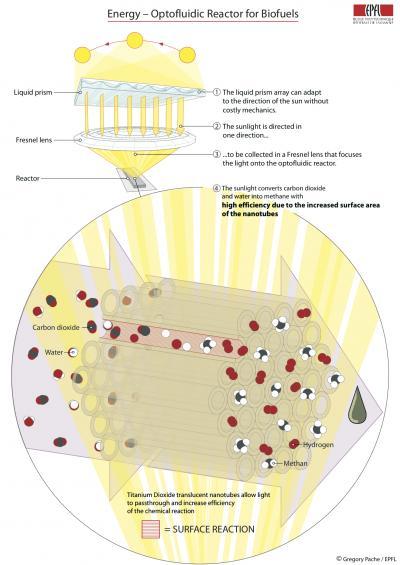Optofluidic solar lighting systems could mean a real boost in solar energy - they capture sunlight from a roof using a light concentrating system that follows the sun's path by changing the angle of the water's refraction, and then distribute the sunlight throughout the building through light pipes or fiber optic cables to the ceilings of office spaces, indoor solar panels, or even microfluidic air filters.
Obviously a concern is how to maintain a comfortable constant light source for ceiling lighting—the flickering of the light source due to a cloud passing over would be annoying. The researchers modulate these different channels to maintain a constant light source using electrowetting. A droplet of water sits on the outer surface of light tube. A small current excites the ions in the water, pushing them to the edge of the droplet and expanding it just enough for it to touch the surface of another tube. This expanded droplet then creates a light bridge between the two parallel light tubes, effectively moderating the amount of light streaming through either one.
By combining nano technology with optics, bioreactors can have increased efficiency -- opening new doors for clean energy production. Credit: EPFL / Greg Pasche
Since most reactions in liquid channels happen at the point of contact between the liquid and the catalyst-lined tubes, the efficiency of a system depends on how much surface area is available for reactions to take place. Scaling down the size of the channels to the micro and nano level allows for thousands more channels in the same available space, greatly increasing the overall surface area and leading to a radical reduction of the size needed (and ultimately the cost) for catalytic and other chemical reactions. Adding a light source as a catalyst to the directed flow of individual molecules in nanotubes allows for extreme control and high efficiency.
Their review in Nature Phontonics lays out several possibilities for up-scaling optofluidics, such as using optical fibers to transport sunlight into large indoor biofuel reactors with mass-produced nanotubes. They point out that the use of smaller spaces could increase power density and reduce operating costs; optofluidics offers flexibility when concentrating and directing sunlight for solar collection and photovoltaic panels; and by increasing surface area, the domain promises to reduce the use of surface catalysts—the most expensive element in many reactors.
"The main challenge optofluidics faces in the energy field is to maintain the precision of nano and micro light and fluid manipulation while creating industrial sized installations large enough to satisfy the population's energy demand," explains David Erickson, professor at Cornell University and visiting professor at EPFL. "Much like a super computer is built out of small elements, up-scaling optofluidic technology would follow a similar model—the integration of many liquid chips to create a super-reactor."



Comments